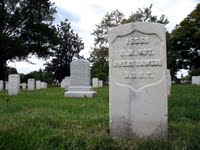Visiting Owens Dawson

Researching the life and times of Q.M. Sgt. Owens Dawson of the Twenty-fifth U.S. Colored Infantry has provided me an opportunity to get to know a man who died fifty-nine years before my birth. I've imagined him waiting on tables in a Philadelphia restaurant before the war, marching to the sound of drum and fife on the drill ground at Camp William Penn, mourning the untimely death of his first wife, traveling to Washington, D.C., to begin a new life, and, in his dotage, chatting up aged veterans at a Grand Army of the Republic reunion.
Today, I visited his grave site at Arlington National Cemetery, located a few miles from my home. I enjoyed a quiet moment to reflect on a life of joy and sorrow, in service of country, for the betterment of our nation.
Little could he have imagined that 105 years after his death that I would be standing at his grave site, snapping pictures of a cool marble slab that marks the spot where his earthly remains lie undisturbed, a silent stone witness to the memory of a man.
Labels: 25th, arlington, army, camp william penn, cemetery, civil war, d.c., dawson, history, military, owens, philadelphia, twenty-fifth, u.s. colored infantry, union, usct, washington

